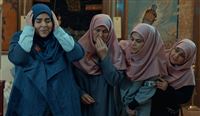Iranians celebrate the National Cinema Day on September 11, corresponding to the 21st of Shahrivar in the Persian calendar.
This special date marks the commemoration of a century of Iranian cinema.
Since the Islamic Revolution, Iranian cinema has made significant progress.
It has explored new themes, including ethical and religious values, gained international acclaim, and participated in global film festivals.
On this important day, iFilm English website offers a look back at the rich history of cinema in Iran:

 The first cinematograph machine was brought to Iran by Mozaffar al-Din Shah in 1900.
The first cinematograph machine was brought to Iran by Mozaffar al-Din Shah in 1900.
Until 1930, no Iranian films were produced, and the few existing cinemas primarily screened Western films with Persian subtitles.
The First Sound Film in Iranian Cinema
In 1933, Iranian cinema achieved a major milestone with the production of ‘The Lor Girl’, the first Persian-language sound film.
Produced by Ardeshir Irani in Mumbai, the film was warmly received, leading to the creation of more Iranian films. Political changes in Iran between 1936 and 1948, compounded by World War II, hindered the budding film industry's development.
During this period, cinema in Iran remained largely an elite pastime due to the limited number of theaters in Tehran and major cities.
 Moreover, there was no distinct artistic movement among filmmakers, except for Abdolhossein Sepanta, whose films incorporated ancient Iranian literary themes. Many Iranian films were adaptations or imitations of foreign works.
Moreover, there was no distinct artistic movement among filmmakers, except for Abdolhossein Sepanta, whose films incorporated ancient Iranian literary themes. Many Iranian films were adaptations or imitations of foreign works.
The Rise of Iranian Cinema
Iran's first public cinema was established in 1904 by Mirza Ibrahim Khan Akkas Bashi. The first official cinema venue, ‘Cinema Iran’, opened in Tehran in 1926.
The filmmaking landscape in Iran saw significant expansion after 1943, with the establishment of numerous film companies by various investors.
Cinema became increasingly popular among the general public. However, this period was marked by a focus on commercial success, resulting in the production of populist, lighthearted films.
 In 1969, a major transformation took place with the release of groundbreaking films such as ‘Gav’ (The Cow), giving rise to the “New Wave of Iranian Cinema”.
In 1969, a major transformation took place with the release of groundbreaking films such as ‘Gav’ (The Cow), giving rise to the “New Wave of Iranian Cinema”.
Filmmakers like Sohrab Sepehri, Bahram Beizaee, Abbas Kiarostami, and others led this cultural renaissance, creating films that reflected deeper, more meaningful narratives.
Cinema after the Islamic Revolution in Iran
Following the Islamic Revolution, Iranian cinema underwent profound cultural changes.
 Filmmakers Abbas Kiarostami, Bahram Beizaee, and Daryoush Mehrjouee were some of the most prominent filmmakers after Iran's Islamic Revolution.
Filmmakers Abbas Kiarostami, Bahram Beizaee, and Daryoush Mehrjouee were some of the most prominent filmmakers after Iran's Islamic Revolution.
Directors such as Ebrahim Hatamikia and Majid Majidi also gained international recognition.
 Additionally, the consistent annual organization of at least one international film festival, notably the Fajr International Film Festival, held during the Persian calendar month of Bahman in Iran, has played a pivotal role in nurturing an interest in cinema among the country's youth.
Additionally, the consistent annual organization of at least one international film festival, notably the Fajr International Film Festival, held during the Persian calendar month of Bahman in Iran, has played a pivotal role in nurturing an interest in cinema among the country's youth.
This festival has also contributed significantly to the advancement of the cinematic art.
The House of Cinema stands as the largest professional organization representing the various facets involved in the production of Iranian cinema.
 Despite substantial international pressures, Iranian cinema has consistently commanded profound respect and recognition.
Despite substantial international pressures, Iranian cinema has consistently commanded profound respect and recognition.

 Movies like ‘Mother’, ‘Sara’, ‘Where Is the Friend's Home?’, ‘Actor’, ‘Taste of Cherry’, ‘A Separation’, ‘Children of Heaven’, ‘Saint Mary’, 'Muhammad: The Messenger of God', ‘I Want to Stay Alive’, ‘The Kingdom of Solomon, the Prophet', ‘Shokaran’, ‘The Bride’, ‘Tenants’, ‘The Red Ribbon’, The Twenty-Ninth Night’, ‘The Color of Paradise’, ‘The Glass Agency’, ‘The Cow’, ‘Mom's Guests’, ‘So Close, So Far Away’, ‘Once Upon a Time, Cinema’, ‘A Piece of Bread’, ‘Track 143’, ‘Chamran’, ‘Captain Khorshid’ and ‘The City of Mice’ represent just a fraction of the diverse and high-quality productions of Iranian cinema since the Islamic Revolution.
Movies like ‘Mother’, ‘Sara’, ‘Where Is the Friend's Home?’, ‘Actor’, ‘Taste of Cherry’, ‘A Separation’, ‘Children of Heaven’, ‘Saint Mary’, 'Muhammad: The Messenger of God', ‘I Want to Stay Alive’, ‘The Kingdom of Solomon, the Prophet', ‘Shokaran’, ‘The Bride’, ‘Tenants’, ‘The Red Ribbon’, The Twenty-Ninth Night’, ‘The Color of Paradise’, ‘The Glass Agency’, ‘The Cow’, ‘Mom's Guests’, ‘So Close, So Far Away’, ‘Once Upon a Time, Cinema’, ‘A Piece of Bread’, ‘Track 143’, ‘Chamran’, ‘Captain Khorshid’ and ‘The City of Mice’ represent just a fraction of the diverse and high-quality productions of Iranian cinema since the Islamic Revolution.
 Iranian cinema has consistently stayed true to its core path. It has achieved numerous remarkable milestones on the global stage. Some of these accomplishments include:
Iranian cinema has consistently stayed true to its core path. It has achieved numerous remarkable milestones on the global stage. Some of these accomplishments include:
- ‘Children of Heaven’ was selected as one of the final five nominees for Best Foreign Film at the 1998 Oscars.
- Golden Palm award at the Cannes Film Festival for ‘Taste of Cherry’ in 1997, directed by Abbas Kiarostami.
- Critics' Award at the London Film Festival in 2002 for ‘I Am Taraneh, 15’, directed by Rasoul Sadrameli.
- Academy Award (Oscar) for Best Foreign Language Film in 2012 for ‘A Separation’, directed by Asghar Farhadi.
- Golden Crow Pheasant Award at the Kerala International Film Festival in India in 2013 for ‘Parviz’, directed by Majid Barzegar.
- Golden Palm Award at the Cannes Film Festival for ‘The Salesman’ in 2016, directed by Asghar Farhadi.
- Golden Palm Award for Best Actor at the Cannes Film Festival in 2016 for Shahab Hosseini’s role in ‘The Salesman’.
Some of the key actors and directors who have significantly shaped Iranian cinema include Mohammad-Ali Keshavarz, Ali Nasirian, Ezzatollah Entezami, Davoud Rashidi, Daryoush Arjmand, Jamshid Hashempour, Parviz Pourhosseini, Reza Zhian, Jaleh Olov, Fakhri Khorvash, Nikou Kheradmand, Hamideh Kheirabadi, Sorayya Qasemi, Jamileh Sheykhi, Parviz Parastouee, Reza Kianian, Merila Zarei, Majid Majidi, Ebrahim Hatamikia, Shahab Hosseini, Asghar Farhadi, Abbas Kiarostami, Daryoush Mehrjouee, Khosro Shakibaee, Hamid Jebeli, Alireza Khamesh, Daryoush Khondji, Abdollah Eskandari, Mahmoud Kalari, Reza Attaran, Pouran Derakhshandeh, Azita Hajiyan, Parviz Shahbazi, and Kamal Tabrizi.


 The first cinematograph machine was brought to Iran by Mozaffar al-Din Shah in 1900.
The first cinematograph machine was brought to Iran by Mozaffar al-Din Shah in 1900. Moreover, there was no distinct artistic movement among filmmakers, except for Abdolhossein Sepanta, whose films incorporated ancient Iranian literary themes. Many Iranian films were adaptations or imitations of foreign works.
Moreover, there was no distinct artistic movement among filmmakers, except for Abdolhossein Sepanta, whose films incorporated ancient Iranian literary themes. Many Iranian films were adaptations or imitations of foreign works. In 1969, a major transformation took place with the release of groundbreaking films such as ‘Gav’ (The Cow), giving rise to the “New Wave of Iranian Cinema”.
In 1969, a major transformation took place with the release of groundbreaking films such as ‘Gav’ (The Cow), giving rise to the “New Wave of Iranian Cinema”. Filmmakers Abbas Kiarostami, Bahram Beizaee, and Daryoush Mehrjouee were some of the most prominent filmmakers after Iran's Islamic Revolution.
Filmmakers Abbas Kiarostami, Bahram Beizaee, and Daryoush Mehrjouee were some of the most prominent filmmakers after Iran's Islamic Revolution. Additionally, the consistent annual organization of at least one international film festival, notably the Fajr International Film Festival, held during the Persian calendar month of Bahman in Iran, has played a pivotal role in nurturing an interest in cinema among the country's youth.
Additionally, the consistent annual organization of at least one international film festival, notably the Fajr International Film Festival, held during the Persian calendar month of Bahman in Iran, has played a pivotal role in nurturing an interest in cinema among the country's youth. Despite substantial international pressures, Iranian cinema has consistently commanded profound respect and recognition.
Despite substantial international pressures, Iranian cinema has consistently commanded profound respect and recognition.
 Movies like ‘Mother’, ‘Sara’, ‘Where Is the Friend's Home?’, ‘Actor’, ‘Taste of Cherry’, ‘A Separation’, ‘Children of Heaven’, ‘Saint Mary’, 'Muhammad: The Messenger of God', ‘I Want to Stay Alive’, ‘The Kingdom of Solomon, the Prophet', ‘Shokaran’, ‘The Bride’, ‘Tenants’, ‘The Red Ribbon’, The Twenty-Ninth Night’, ‘The Color of Paradise’, ‘The Glass Agency’, ‘The Cow’, ‘Mom's Guests’, ‘So Close, So Far Away’, ‘Once Upon a Time, Cinema’, ‘A Piece of Bread’, ‘Track 143’, ‘Chamran’, ‘Captain Khorshid’ and ‘The City of Mice’ represent just a fraction of the diverse and high-quality productions of Iranian cinema since the Islamic Revolution.
Movies like ‘Mother’, ‘Sara’, ‘Where Is the Friend's Home?’, ‘Actor’, ‘Taste of Cherry’, ‘A Separation’, ‘Children of Heaven’, ‘Saint Mary’, 'Muhammad: The Messenger of God', ‘I Want to Stay Alive’, ‘The Kingdom of Solomon, the Prophet', ‘Shokaran’, ‘The Bride’, ‘Tenants’, ‘The Red Ribbon’, The Twenty-Ninth Night’, ‘The Color of Paradise’, ‘The Glass Agency’, ‘The Cow’, ‘Mom's Guests’, ‘So Close, So Far Away’, ‘Once Upon a Time, Cinema’, ‘A Piece of Bread’, ‘Track 143’, ‘Chamran’, ‘Captain Khorshid’ and ‘The City of Mice’ represent just a fraction of the diverse and high-quality productions of Iranian cinema since the Islamic Revolution. Iranian cinema has consistently stayed true to its core path. It has achieved numerous remarkable milestones on the global stage. Some of these accomplishments include:
Iranian cinema has consistently stayed true to its core path. It has achieved numerous remarkable milestones on the global stage. Some of these accomplishments include:





